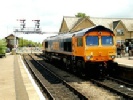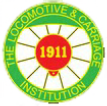Archive Section




Stuart Smith
A small group of invited members met at Stratford International station for the short transfer to nearby Temple Mills Eurostar Depot.
Once cleared through security and an x-
The whole depot complex is around 2 kilometres from end to end, and comprises of an 8-
A Eurostar set, or TransManche Super Train (Cross-
A full 20-
The first building we entered was adorned with the nameplate "THE WHITE ROSE", which was taken from one of the GNER 'Eurostar' sets, when they came off lease from those services in December 2005.
Exiting from the lift on the above floor, we found ourselves looking down over the eight maintenance roads. Five full Eurostar sets were present -
The various maintenance regimes were explained in detail to us, along with some of the codes used by staff at the depot.
A Grand Visit General (GVG) is carried out every three years on each set, with more regular routine checks done in between as required. A GVG takes between 11-
A large digital display board is located adjacent to the buffer stops within the building, and this details each stabled train and the various tasks to be undertaken upon them. Also listed is the 'expected' departure time for the set.
Whilst we were in this location, a sixth train entered the facility driven by one of the London-
The sets are capable of operating on 25kV AC, 3000V DC, 1500V DC and 750V DC 'Third Rail', although as the sets go through their 3-
6 of the 8 roads within the maintenance building have the facility to undertake the removal of roof equipment and pantographs etc,.
Overhead 'neutral' sections within the building facilitate this work.
Heading down to the ground level again, we were shown the Plant Equipment Repair (dealing with all kinds of mechanical equipment and forklifts etc), plus the immense area containing the Spare Parts Factory. It was commented at this point, that apart from the actual shell of the Eurostar train, this area houses just about everything else needed to construct a working train!!!
We passed in front of the very busy Team Leaders Office -
A small office next door housed the Operations Control (or Signal Box), which controls the movements within the depot complex, as well as having contact with the 'outside railway', for sets arriving and departing.
Parked adjacent to these offices is a fleet of pink bicycles used by staff to get around the vast site. Pink being used as an easy way to identify them within the depot confines so we were told.
We next made our way outside, and got our first sighting of one of the new Velaro sets (374007/4008). This was parked next to a single e300 power car (373006) with the distinct external differences between the two types of train clear and obvious to see.
Peter at this point explained that originally the new Siemens-
An average night at the depot sees sets arriving at roughly half-
Another (and more important) issue of the overcrowding, is the inability to accept any further deliveries of Velaro trains from the Siemens factory in Germany. Currently only three sets are in the UK; two of which are at Temple Mills, with the third out-
From here we were able to 'get up close and personal', with one of the stabled sets, and Peter expertly explained the various features as we walked along the full length of the train.
An issue that is still rife today on cross-
The next part of our visit saw us cross to the Wheel Lathe / Bogie Drop Facility. This is a 3-
To conclude our visit, we were invited into the cab of power car 3218. The compact and dated nature was instantly apparent. Several pieces of outdated equipment are still retained, such as NRN radio and third-
The drivers 'blinkered view' was also clear to see, but fully justified as a means of ensuring concentration (and to limit the distraction/interference in the drivers peripheral vision) when travelling at 186mph. Hypnosis is a real and significant threat at high speed from Overhead Line Equipment (OLE).
Even though it is electric traction (albeit stationary at this point), the opening of the cab door behind us, demonstrated the ideal cab environment being maintained by the soundproofing insulation on the bulkhead walls/doors.
Concluding our excellent visit, we were escorted back to the security buildings where we said our goodbyes (and thank you's) to our host, Peter De Lacey
With this small visit undertaken successfully, it is hoped that we will be able to offer a repeat visit in the not too distant future, and open it up to the general membership.